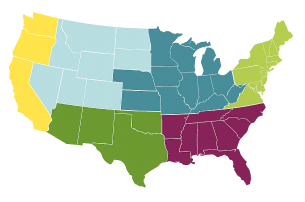
How do we use your location?
Knowing your location helps us recommend plants that will thrive in your climate, based on your Growing Zone.
A Beautiful mixture of Hyacinthoides, commonly known as wood Hyacinths come in striking shades of pink, blue and white flowers. These woodland Hyacinths are perfect for rock gardens, beds and borders, under trees and shrubs or co-plant them with later blooming spring bulbs. They will naturalize very well which means they come back year after year and will last a lifetime.
If you happen to be in Europe in spring, this is the beautiful wildflower you'll see in Spain's woodland areas. The wild form is purple/blue, and it has so many common names we can't list them all! Some call it Spanish Bluebell, others insist it's English Wood Hyacinth, and others just call them Scilla. This famous wildflower even has several botanical names (see above).
But whatever you call it, you'll love the nodding flowers and the plant's habit of spreading into larger and larger clumps. It's great in bulb gardens, perennial borders, along walks--anywhere you'd like lovely spring color year after year. And if you have a woodland area, it's a great naturalizer.
Our bulbs are actually the Spanish Bluebell type, and they are somewhat larger and different from English Bluebells. In fact, the Spanish type have been planted in England and there is concern there since the Spanish variety is crossing with the English type, and some conservationists there are concerned the Spanish 'Invader' will overwhelm the native English Bluebell. Fortunately, we have no problem here in No. America, since we have no native species. The Dutch breeders ship us the Spanish type since they are the larger flowers, and now available in several colors.'
As soon as your order is placed you will receive a confirmation email. You will receive a second email the day your order ships telling you how it has been sent. Some perennials are shipped as potted plants, some as perennial roots packed in peat. The ‘Plant Information’ section describes how that item will ship. All perennials and fall-planted bulbs are packaged to withstand shipping and are fully-guaranteed. Please open upon receipt and follow the instructions included.
Perennials and fall-planted bulbs are shipped at the proper planting time for your Growing Zone. Perennial and fall-planted bulb orders will arrive separately from seeds. If your order requires more than one shipment and all items are shipping to the same address, there is no additional shipping charge. See our shipping information page for approximate ship dates and more detailed information. If you have any questions, please call Customer Service at (802) 227-7200 or contact us by email or chat.